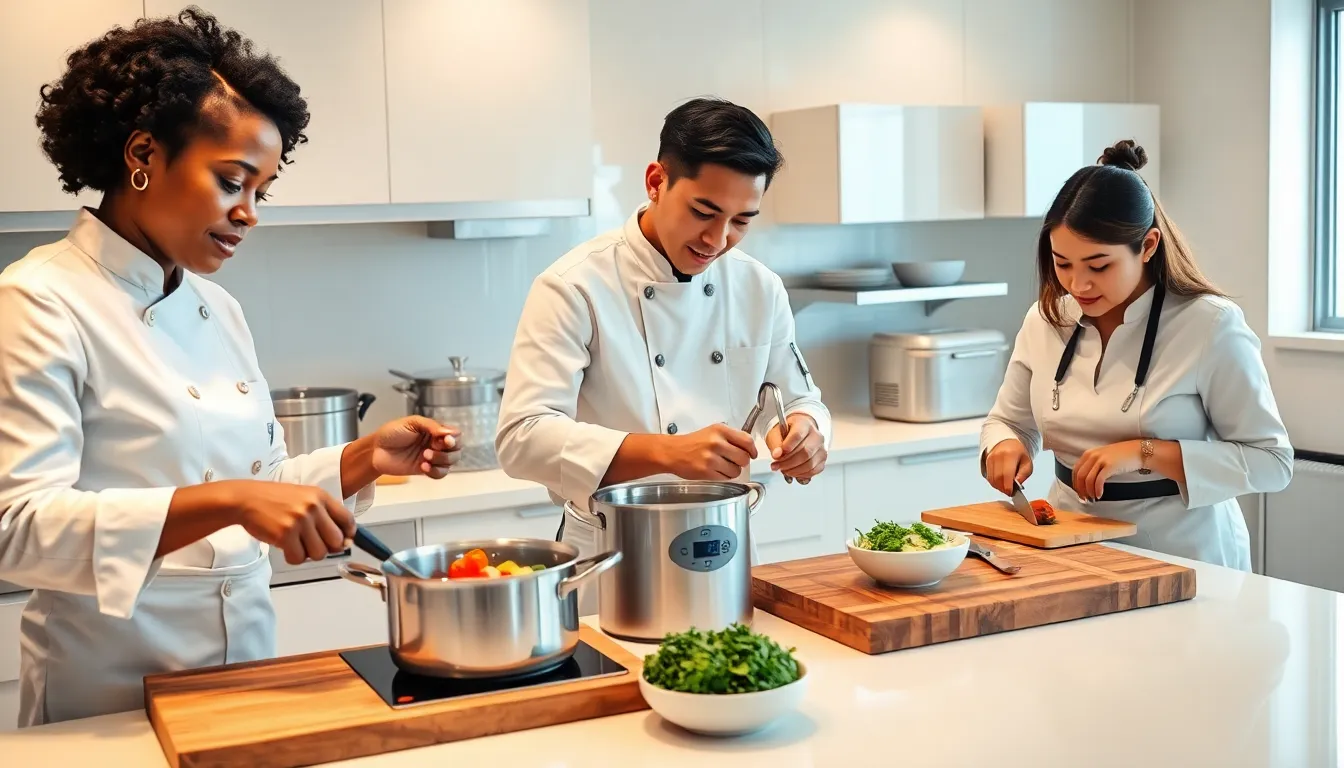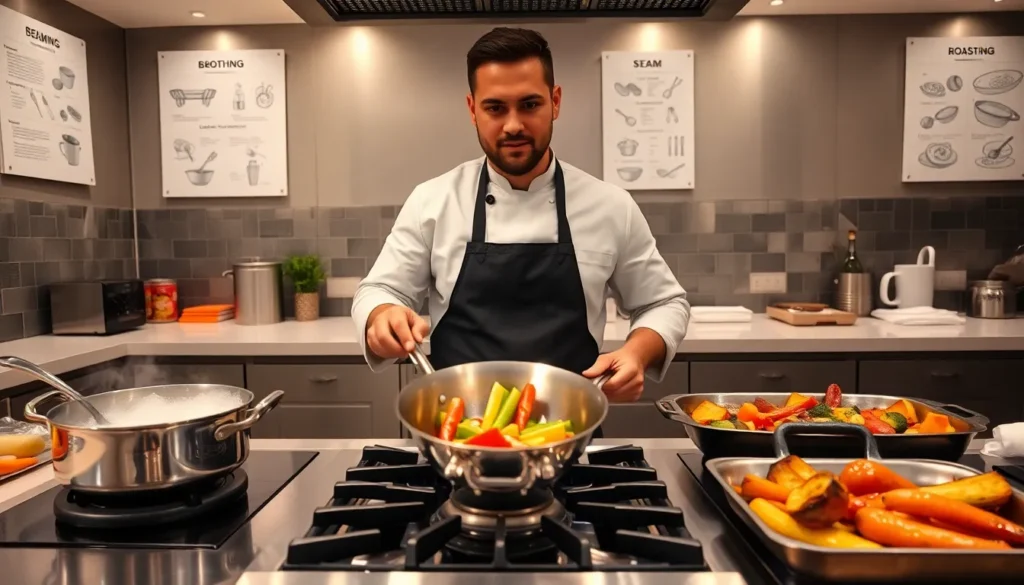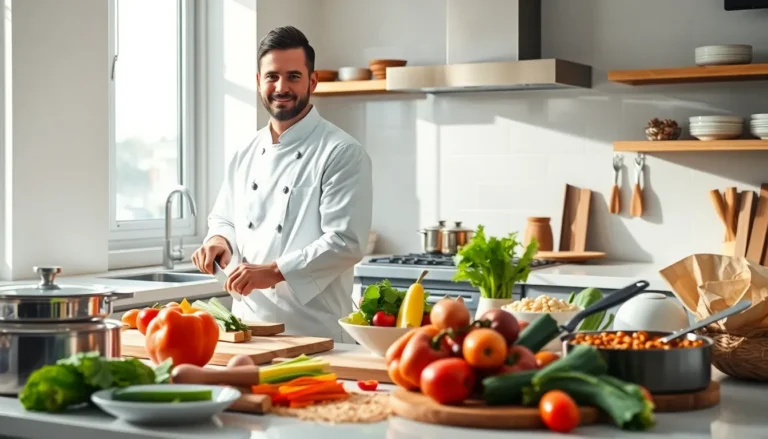Table of Contents
ToggleEver find yourself staring blankly at a recipe, wondering what half the cooking terms even mean? Well, worry no more. Understanding cooking techniques is key to transforming your culinary dreams into delicious realities. Whether you’re a ‘master chef’ in your own kitchen or just starting out, this cooking techniques list has something for everyone. Grab your apron, because it’s time to jump into the world of boiling, sautéing, and even a little molecular gastronomy. Yes, it sounds fancy, but trust me, it’s all in a day’s work for a kitchen magician.
Introduction to Cooking Techniques

Cooking is an art form, and like any artist, a chef must be well-versed in various techniques to truly create masterpieces. The beauty of cooking lies in the diversity of the methods used. From the simplicity of boiling to the elegance of sous vide, each technique has its own flair and purpose. This comprehensive cooking techniques list will provide insights and guidelines to help elevate dishes from ordinary to extraordinary. Let’s break it down into three main categories: basic, advanced, and specialized techniques.
Basic Cooking Techniques
1. Boiling
Boiling is the go-to technique for making pasta and cooking vegetables. It involves immersing food in water heated to 212°F (100°C) until it is fully cooked. The process is straightforward, yet the outcome can vary significantly based on timing and ingredient preparation.
2. Steaming
For a healthier alternative to boiling, steaming is a fantastic choice. This technique uses the steam generated from boiling water to cook food. It retains nutrients better than boiling, making it a favorite for vegetables and seafood.
3. Poaching
Poaching involves gently cooking food in a simmering liquid, which is usually water, broth, or wine. Ideal for delicate ingredients like eggs or fish, poaching avoids the risk of toughening proteins, resulting in a tender texture.
4. Sautéing
Sautéing is a quick cooking method where food is cooked in a small amount of oil or fat over relatively high heat. This technique is perfect for vegetables and proteins, allowing them to develop a lovely caramelization on the outside while retaining moisture within.
5. Frying
Frying takes it a notch higher by immersing food in hot oil. This method yields crispy, flavorful results, whether you’re making French fries or fried chicken. Just remember, moderation is key with this indulgent technique.
Advanced Cooking Techniques
1. Baking
Baking employs dry heat in an oven to cook food. Perfect for pastries, bread, and casseroles, baking requires accuracy in following recipes, making it somewhat of a science as much as an art.
2. Roasting
Roasting involves cooking food evenly in an oven, allowing the natural sugars to caramelize, enhancing flavor. This technique excels with meats, vegetables, and even fruits.
3. Grilling
Grilling provides a unique smoky flavor by exposing food to direct heat. Whether on a backyard barbecue or a stovetop grill, this method is perfect for meats and veggies alike.
4. Braising and Stewing
These techniques combine wet and dry cooking methods. Braising typically features large cuts of meat cooked slowly in a small amount of liquid, while stewing involves smaller pieces immersed in a flavorful broth. Both result in tender, delicious dishes.
5. Sous Vide
Sous vide, meaning “under vacuum” in French, entails sealing food in a bag and cooking it in a water bath at a precise temperature. This innovative technique ensures perfectly tender and evenly cooked meals. It’s gaining popularity among food enthusiasts and professionals alike.
Specialized Cooking Techniques
1. Fermenting
Fermentation is a time-honored technique that uses microorganisms like bacteria and yeast to transform food. Think of yogurt and sauerkraut. It’s not just about flavor: fermentation also enhances the nutritional profile of foods.
2. Smoking
Smoking adds a rich, complex flavor to meats, cheeses, and even vegetables. Whether using a traditional smoker or a stovetop method, the process involves exposing food to smoke from burning or smoldering materials, typically wood.
3. Blast Chilling
Blast chilling is used mainly in restaurants to cool cooked food rapidly. This method ensures food safety by preventing the growth of harmful bacteria, while also preserving texture and flavor.
4. Pressure Cooking
A pressure cooker uses steam and pressure to cook food faster. Ideal for beans and tough cuts of meat, this method drastically reduces cooking times while enhancing flavors.
5. Molecular Gastronomy
This avant-garde technique combines food science and artistry. By using unusual combinations and techniques such as gelification and foaming, chefs create extraordinary textures and flavors, transforming traditional dishes into unexpected sensations.
Choosing the Right Technique for Your Dish
Selecting the appropriate cooking technique can make or break a dish. It’s essential to consider the ingredient’s textures, flavors, and desired outcome. For instance, delicate proteins like fish are best poached or steamed, while hearty vegetables shine when roasted or grilled. Looking for a warm, comforting dish? Go for braising. Want to impress with a restaurant-style plate? Sous vide may be your best friend. Understanding the nuances of each technique arms cooks with choices that will elevate their culinary creations.



